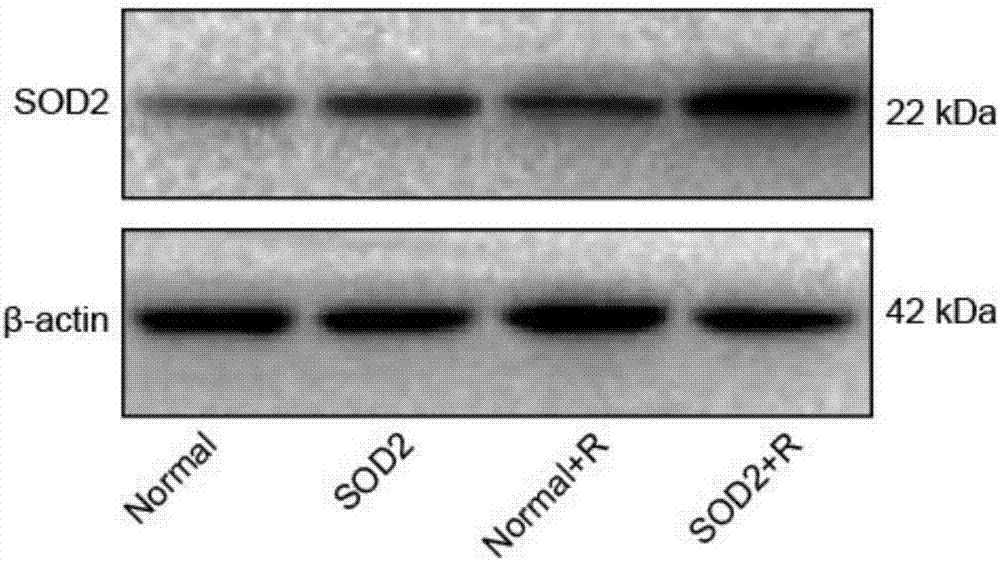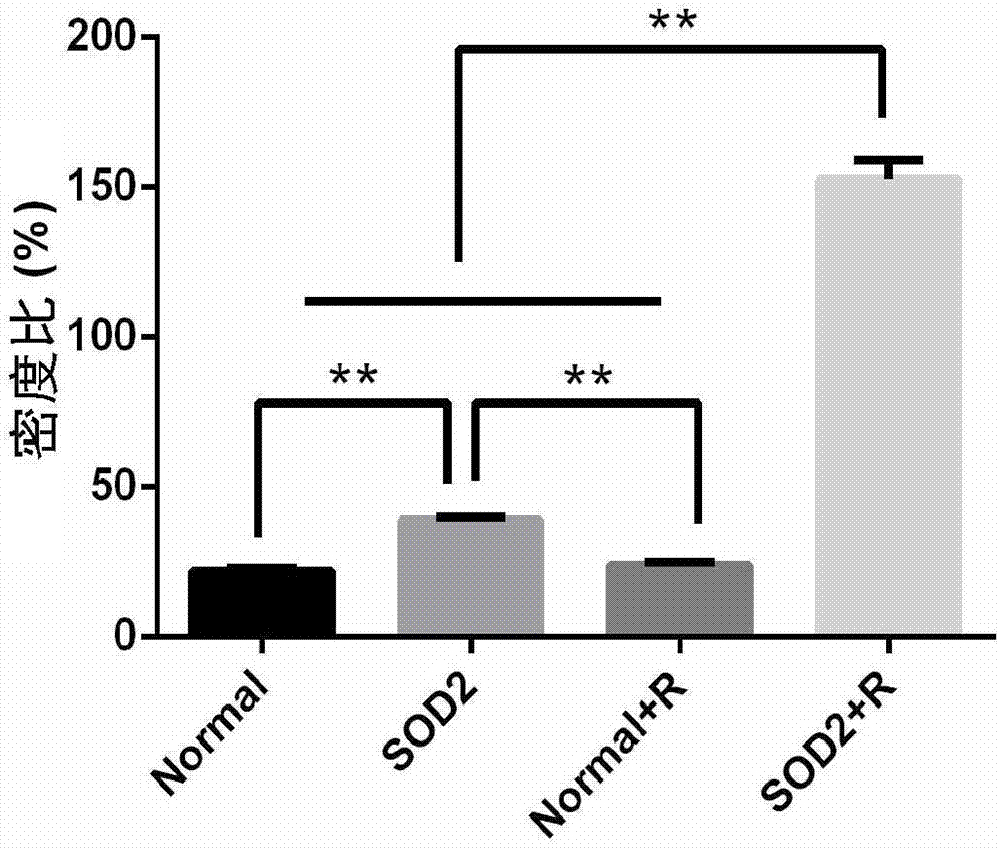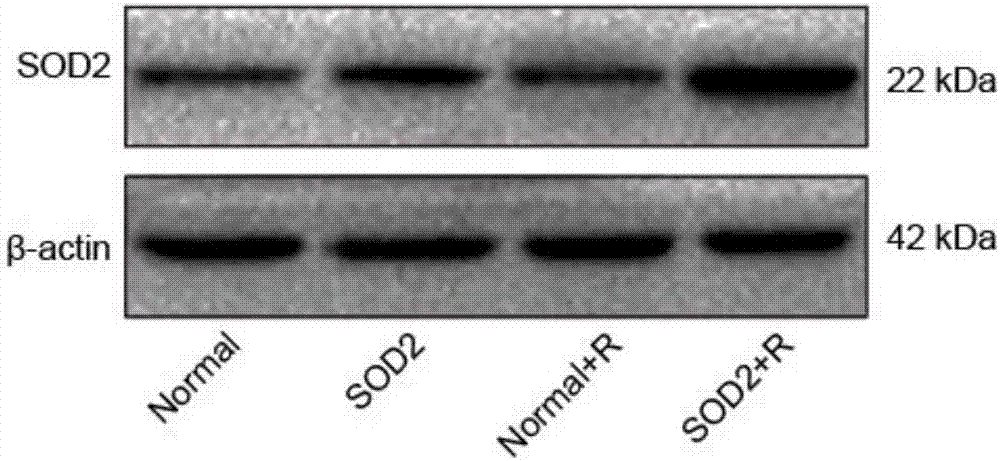SOD2 lentiviral vector, construction method and application thereof in targeted radiation protection and tumor sensitization
A technology of lentiviral vector and construction method, which is applied in the application field of SOD2 lentiviral vector, targeted radiation protection and tumor sensitization, can solve the problems of restricting the popularization and application of SOD2 gene therapy, so as to increase sensitivity and reduce apoptosis Mortality Effect
- Summary
- Abstract
- Description
- Claims
- Application Information
AI Technical Summary
Problems solved by technology
Method used
Image
Examples
Embodiment 1
[0046] SOD2 lentiviral vector pLVX-C 9 The construction method of BC-SOD2-T2A-AcGFP1 comprises the following steps:
[0047] (1) Synthesis of CArG 9 , CMV basic promoter chimeric promoter C 9 BC gene fragment, the C 9 The upstream of the BC gene fragment contains a Cla I restriction site, and the downstream contains an Xho I restriction site;
[0048] (2), Cla I, Xho I double enzyme digestion lentiviral vector pLVX-AcGFP1-N1, the original vector backbone CMV promoter was removed; Cla I, Xho I double enzyme digestion full gene fragment, obtained radiation-induced promoter C 9 BC; will C 9 The BC promoter was ligated to the pLVX-AcGFP1-N1 fragment in which the CMV promoter was excised to obtain pLVX-C 9 BC-AcGFP1-N1;
[0049] (3) Using cDNA as a template to amplify the entire SOD2 gene fragment, the entire gene fragment contains the kozak sequence, the upstream of SOD2 contains the Xho I restriction site, and the downstream contains the BspT104I restriction site; Xho I, Bs...
Embodiment 2
[0079] Effect of irradiation treatment on the expression of SOD2 protein in stable cell lines
[0080] Given that 2-8Gy can effectively activate the chimeric promoter C 9 For the transcription of downstream genes by BC, experiments at the cell and animal levels were irradiated with γ-rays, with a total dose of 6Gy; animal experiments were irradiated with a single dose of 2Gy, once a day, for 3 consecutive days; experiments at the cell level were irradiated with a single dose of 6Gy method.
[0081] After observing 6Gy irradiation, the treatment vector (pLVX-C 9 BC-SOD2-T2A-AcGFP1) stable expression cell lines HT-29 and CCD 841 CoN expression changes of SOD2, combined with the previous part of the experimental results, 48h after irradiation treatment by western blot detection. The results showed that, compared with other groups, the expression of SOD2 in HT-29 stably transfected cell line was significantly increased after 6Gy irradiation ( Picture 1-1 and 1-2 ), the differe...
Embodiment 3
[0084] Effect of SOD2 overexpression on the proliferation ability of stable cell lines
[0085] The CCK-8 cell proliferation assay was used to detect the changes in cell proliferation ability among different cell groups. Experimental results such as image 3 shown. At 48h after irradiation, the cell proliferation ability of the SOD2+R group was lower than that of the Normal+R group, and the difference was significant (P<0.05); at 72h, the trend was more obvious, and the cell proliferation ability of the SOD2+R group was significantly lower than that of the Normal+R group ( P<0.01). It shows that the overexpression of SOD2 can increase the sensitivity of tumor cell HT-29 to radiation treatment and enhance the effect of radiation therapy.
[0086] Compared with the Normal+R group, the CCD 841 CoN stably transfected cell lines irradiated with 6Gy tended to improve the proliferation ability at 24h and 48h, but the difference was not significant. The cell proliferation ability ...
PUM
 Login to View More
Login to View More Abstract
Description
Claims
Application Information
 Login to View More
Login to View More - R&D
- Intellectual Property
- Life Sciences
- Materials
- Tech Scout
- Unparalleled Data Quality
- Higher Quality Content
- 60% Fewer Hallucinations
Browse by: Latest US Patents, China's latest patents, Technical Efficacy Thesaurus, Application Domain, Technology Topic, Popular Technical Reports.
© 2025 PatSnap. All rights reserved.Legal|Privacy policy|Modern Slavery Act Transparency Statement|Sitemap|About US| Contact US: help@patsnap.com



